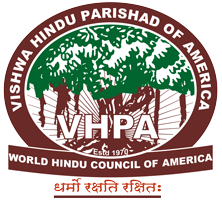According to the VHPA, Hindus are all those who believe, practice, or respect the spiritual and religious principles and practices having roots in Bharat. Thus Hindu includes Jains, Buddhas, Sikhs and Dharmic people, worldwide, of many different sects within the Hindu ethos.
The word Hindu is a civilizational term expressed as Hindu culture or “Sanskriti.” And the word Dharma includes religious practices only as a subset. The parishad welcomes and respects people of non-Indian origin who consider themselves Hindus as defined above.
Bhagwa Dhwaj (Saffron Flag of the Hindus)
Bhagwa Dhwaj, one of the great Hindu symbols, signifies sacrifice, knowledge, purity and service.
The Bhagwa Dhwaj is the eternal symbol of Hindu culture and Dharma. It adorns every ashram, every temple, the army of Chatrapati Shivaji, Guru Gobind Singh, and the chariots of Sri Ram, Sri Krishna and Arjuna. It stands for Dharma, wealth, advancement, glory, knowledge and detachment. The combination of these six aspirations is “Bhagwa.”
The color of the flag is Saffron. It is the color of FIRE – its flames. The fire is a great purifier, the eternal witness of all Yagnas, of all the offerings. It inspires the greatest of all human values, sacrifice, the very essence of Hindu Dharma. The the color reminds us of the orange hue around the rising Sun, that dispels darkness and radiates light all around. It beckon us to shake of our lethargy (Arise, Awake!), and get down to our duty. The Sun burns throughout the day, silently sacrificing itself, thereby, giving life to all creatures on this planet, without demanding anything in return. And as it sets, it teaches us to have no expectations, no regrets; just ceaselessly (nitya and akhand) render service to all creatures.
Its shape consists of two triangles: the upper being shorter than the lower one. The triangles represent the rising flames of the burning fire. The flames rise upwards only – those rising from the bottom being the longest. They teach us to “rise above and become better always.”
The shape of the Bhagwa has another significance: diversity, acceptance, harmony and mutual respect. The small and the large portions remind us that duality, contrast, inequality, diversity are inevitable. For harmonious existence there must be sharing, respect and cooperation – the burden must always be on the big to support the small.
The Bhagwa has been the silent witness of our long history. In its folds resides the images, the memories, the tapas of our ancestors, our Rishis, our Mothers. It is our greatest Guru, our Guide, inspiring us forever to live the life full of sublime virtues based on sacrifice, dedication, purity and service.
Vat Vrikhsha – The Glory of Hindu Sanskriti (Heritage)
A beautiful poem in Hindi that captures so succinctly the core of Hindu Sanskriti – symbolized here as a Vat-Vriksha (the Banyan tree).
Hindu Sanskriti Ke Vat Vishaal
Teri Choti Nabh Chooti Hai, Teri Jad Pahunch Rahi Paataal.
Hindu Sanskriti Ke Vat Vishaal. (1)
Jaane Kitne Hi Surya-yodaya, Madhyanh Asta Se Tu Khela
Jaane Kitne Toofano Ko, Tune Nij Jeevan Mein Jhela
Kitnee Kirnoan Se Lipati Hai, Teri Shakhayein Daal Daal.
Hindu Sanskriti Ke Vat Vishaal. (2)
Jane Kitne Priya Jeevoan Ne, Tujhme Nij Needa Basaya Hai
Jane Kitne Yaatri-Ganda Ne, Aa Rain Basera Paaya Hai
Kitne Sharnagat Pooj Rahe, Tera Udaartam Antaraal.
Hindu Sanskriti Ke Vat Vishaal. (3)
Kucch Dushtoan Ne Jad Bhi Khodi, Shakha Todi, Patte Kheenche
Phir Kayee Vidheshi Tattvoan Ke, Visha Se Jad Ke Tukade Seenche
Par Saphal Aaj Tak Nahin Hui, Un Moodh Janoan Ki Kutil Chaal.
Hindu Sanskriti Ke Vat Vishaal. (4)
An-Gin Shakhayen Badhati Hain, Dharti Me Mool Pakadti Hain
Ho Antar-vishta Samashti Sama, Ve Tera Poshan Karti Hain
Tujhme Aisee Hee Mil Jaati, Jaise Sagar Mein
Sarit Maal Hindu Sanskriti Ke Vat Vishaal. (5)
Unmukta Hua, Laharata Rah, Chaaya Amrit Barsata Rah
O, Jag Ke Priya Vat-vriksha Sada, Santaano Ko Sar Saata Rah
Jag Me Sab Se Unchaa Deekhe, Shraddha-spad, Tera Bhavya Bhal
Hindu Sanskriti Ke Vat Vishaal. (6)

